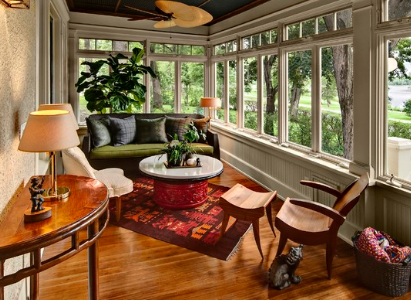

The fern-leaf fig tree often appears in design-inspired photos – and for good reason. The fluffy, large green leaves of the ficus make the room look brighter and make people feel happier. Despite its common name, this tropical native plant rarely bears fruit when grown indoors. If you decide to grow a plant at home, look for specimens at a nursery or home improvement store that sells the plant. Place it in a place where it can receive indirect sunlight, water it once a week, or when the soil is dry to the touch, make sure it is in a well-drained pot, and if its roots start to grow, repot it in the spring. The bottom of the container.

It’s a rare room that looks better without greenery. In this Chicago home, a fig tree echoes the plants outside the large window.

If one tree is good, it may be better to plant two trees on either side of the fireplace.

Part of the reason why fern-leaf figs are loved by people is because of their peculiar properties. The tree has grown quite large (up to 12 feet tall indoors) and whimsically stretches out to the entire room in a house renovated in Los Angeles in 1938.

Another large-scale example occupies the living room corner of a California beach hut, adding to the eclectic look of the design.

And what could be better than figs alone? This room includes not only the tree, but also the curtains on textiles designed by Peter Dunham that display its leaves, aptly named fig leaves.

These houseplants are popular in the living room, and their verdant leaves also brighten up the bedroom. Is this another interesting example of tree mirrored textiles – or is it the other way around?

Imagine this bedroom without figs, a powerful testament to the notion that greenery gives a room an important sense of life.

The tree stands out against the white walls, highlighting the greenery.

It is also striking in front of a vivid coral wall. What a fun gesture to put it next to a photo of the orchard.

A well-lit entrance can be a good place to place your figs. In this example, the leaves rise perfectly to the height of the balustrade, presenting a dramatic exuberance.

People don’t usually think of placing a tree in the kitchen, but if there’s space in the corner next to the window, why not?

There shouldn’t be a tree in the bathroom either, but there seems to be enough light coming in through the window behind the fig for the position to work.

An increasingly popular accessory, the fern leaf fig doesn’t seem to favor one style over the other, and looks just like home in this medieval modern room in Los Angeles.

On the other hand, the tree is equally suitable for a Victorian dwelling.

In this enclosed porch, the fig tree behind the sofa creates an effective visual bridge for the greenery outside the window.
So, if you’re looking to add a little tenderness to your home accessories, consider bringing these glamorous beauties into your own room.